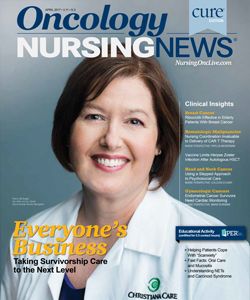Capturing the Patient's Voice: Reporting Cancer Treatment Toxicities in Clinical Trials
The voice of the patient during clinical trials must be captured, to fully record the impact of treatment toxicity and symptoms.
Janice Withycombe, PhD, RN, MN, CCRP

Janice Withycombe, PhD, RN, MN, CCRP
Kate A. Yeager, PhD, RN, FAAN
Janice Withycombe and Kate A. Yeager are assistant professors at the Nell Hodgson Woodruff School of Nursing, Emory University, Atlanta, Georgia.
Significant progress has occurred in cancer treatment which has resulted in improved survival rates, but treatment toxicities are often a byproduct of therapy and these toxicities can negatively impact quality of life.
For patients enrolled in oncology clinical trials, mandatory reporting of adverse events (AEs) during cancer therapy is required by the federal government. The Common Terminology Criteria for Adverse Events (CTCAETM) is the reference book used by clinicians to complete this mandated AE reporting; however, up to one-third of the items in the CTCAE manual have some subjective component and are therefore best reported by patients. For this reason, it is imperative that the voice of the patient be captured, so that the full impact of treatment toxicity and symptoms is understood.
Patient reported outcomes (PROs) are defined as data reported directly from patients without interpretation from others. PROs produce useful metrics, which inherently provide more accurate data for subjective symptoms compared with clinician reporting. In fact, the more subjective the symptom, the lower the clinician—patient agreement of ratings of presence, frequency, and severity.1 For these reasons, the medical community has embraced, for over 2 decades, the fact that the most valid measure of a patient’s pain is the patient’s self-report of pain.2
Nonetheless, investigators on clinical trials and clinical projects have been slow to adopt PRO metrics for other symptoms that are predominantly subjective (eg, cognitive problems, fatigue). PROs provide essential information for the assessment of the value of treatments, such as independent prognostication of survival across cancer sites3 and issues related to patient treatment adherence.
When patients refuse to take a medication as prescribed due to treatment-related symptoms, there is no value of that drug to the patient. The need for standard inclusion of PRO measures becomes even more pressing as we move forward with clinical trials of precision medicines, many of which include oral medications with multiple side effects that patients manage at home.
PRO-CTCAE INTEGRATION IN ADULT ONCOLOGY
The National Cancer Institute (NCI) has been an international leader in providing metrics for toxicity and symptom assessments in clinical research, beginning with the CTCAE (now version 4).4 The NCI also supported the recent development and validation of the patient-reported version of the CTCAE, the PRO-CTCAE.5
A core set of 12 symptoms—specifically, fatigue, insomnia, pain, anorexia (appetite loss), dyspnea, cognitive problems, anxiety (includes worry), nausea, depression (includes sadness), sensory neuropathy, constipation, and diarrhea—were included in the final recommendation for inclusion in clinical trials where a PRO is measured.
The NCI advises that PRO-CTCAE should be used and reported in conjunction with the CTCAE reports gathered by clinicians. This patient data provides additional information that is complementary to existing safety and tolerability assessments reported by clinicians using the CTCAE. The choice of PRO-CTCAE items is dependent upon anticipated AEs based upon previous preclinical data and regimen-specific information.
PEDIATRIC PRO-CTCAE
Research has shown that children are also able to selfreport their symptoms during cancer therapy. The creation and validation of pediatric-specific PRO instruments requires careful consideration for the developmental stage of the child as well as emerging literacy skills. Some instruments have sucessfully been used in children as young as 5 years of age, but most have a lower age limit of 7 to 8 years.
A Pediatric PRO-CTCAE measure has now been developed6 and is currently undergoing validation testing in children aged 7 to 18 years. For children younger than age 7, or otherwise not able to self-report, a proxy version of the Pediatric PRO-CTCAE instrument exists. Although patient report is considered the gold standard, parent or proxy report is necessary when working with very young children and infants.
The Pediatric PRO-CTCAE is a library of 62 AEs which are subjective in nature and amenable for self-report in children. Fifteen core items (common across all childhood cancer therapies) have been identified: abdominal pain, anorexia, anxiety, constipation, cough, depression, diarrhea, fatigue, headache, insomnia, oral mucositis, nausea, pain, peripheral sensory neuropathy, and vomiting.
As some clinical trials span multiple ages, there is a need to consistently capture PROs accoss wide age ranges. The adult version of the PRO-CTCAE has recently been tested and proved to be well understood by children as young as 16 years of age.7 This has implications for use in clinical trials which have eligibility criteria to allow enrollment of both adolescents and older adults.
Although strong efforts have been made in adult oncology to routinely integrate PRO reporting in clinical trials, less progress has been made in pediatric oncology. Future research is needed to examine how to effectively provide healthcare practitioners with clinically useful results from PROs so that patient symptoms can be best managed in a timely manner.
One limitation of PROs is that not all patients are able to self-report secondary to literacy issues or visual/cognitive impairments. More work is needed to expand methods of capturing PROs in this disadvantaged population. Recently, the use of PROs is being explored by some as an alternative endpoint of cancer therapy.8 Open dialogue regarding PRO use within oncology is warranted as well as additional research to examine the benefits and/or limitations of integrating PROs into all cancer clinical trials.

Nursing Perspectives on Managing Toxicities With ADCs in Metastatic Gastric and Breast Cancers
September 1st 2022In this episode of "The Vitals," Sarah Donahue, MPH, NP, AOCNP; Jamie Carroll, APRN, CNP, MSN; Theresa Wicklin Gillespie, PhD, MA, RN, FAAN; and Elizabeth Prechtel-Dunphy, DNP, RN, ANP-BC, AOCN, exchange clinical pearls for treating patients receiving antibody-drug conjugates.



